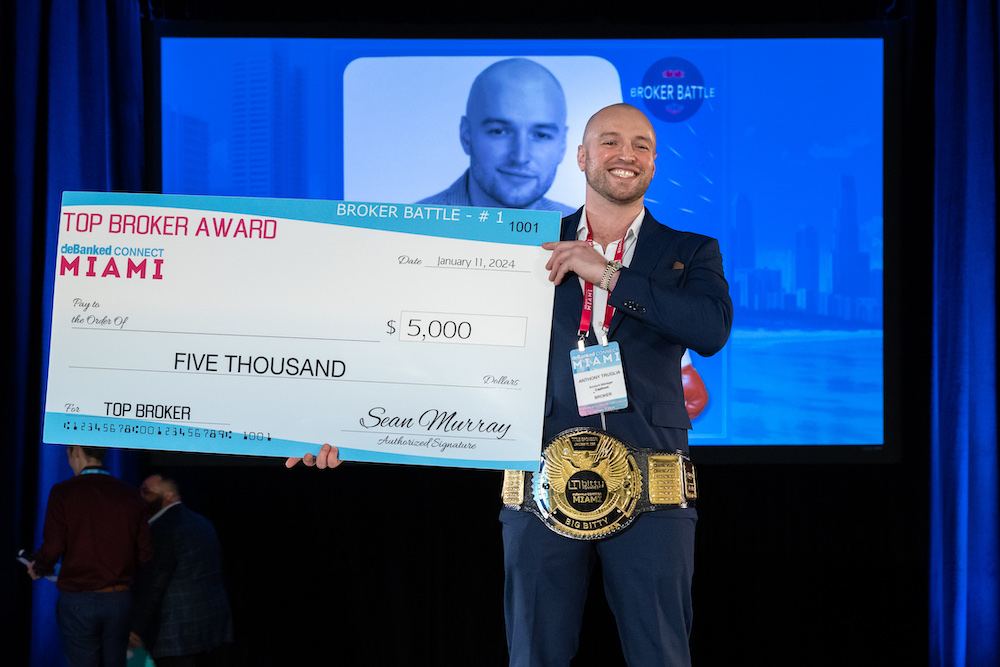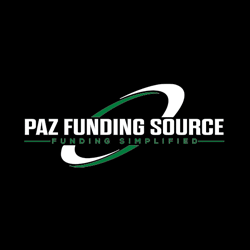Uncategorized
The Story Behind the Broker Battle Champion
January 26, 2024 “I think I’m the best because I understand my clients very, very well,” said Anthony Truglia, an Account Manager at CapFront. “I listen to them, I ask the right questions, and I really try to dive very deeply into what it is the problem that they’re facing, and I try to find a solution to it to the best of my abilities.”
“I think I’m the best because I understand my clients very, very well,” said Anthony Truglia, an Account Manager at CapFront. “I listen to them, I ask the right questions, and I really try to dive very deeply into what it is the problem that they’re facing, and I try to find a solution to it to the best of my abilities.”
Truglia uttered these lines in a calm baritone voice on the red carpet at deBanked CONNECT MIAMI just hours before the inaugural Broker Battle in which he had been accepted as a contestant. The contest was designed to showcase the top brokers taking real but hypothetical questions and applying their knowledge live on stage.
At the time, Truglia had no idea how it was going to be conducted, not to mention that the other highly qualified contestants had also projected equally similar confidence in the likelihoods that they were going to win. It was anyone’s game at that point and the suspense was palpable. There had never been anything like it.
“I’m definitely going to be watching that,” said Manny Yosipov of Advanced Recovery Group during a show floor interview before it took place. “I’ve never seen a broker battle, never heard of a broker battle.”
“Broker Battle is huge because it shows the level that you can reach of talking to these clients, dealing with objections, and just selling in general,” said Joshua Hillian, Creative Director at Advance Funds Network. “I think a lot of people have the wrong idea of sales–but at the end of the day it’s question-based, customer focused, and that’s what it’s about.”
Hillian’s colleague Irving Betesh was slated to go first in the Battle later that evening. Betesh, like others, said that they had been preparing for this day well in advance. There was an overwhelming desire from all of them to showcase not only their technical knowledge but also their friendly diagnostic qualities. This was an educational opportunity for everyone.
 When it finally kicked off, Truglia and Betesh squared off against fellow contestants Corey Digi, Stanley Mitchell, Danielle Rivelli, and Mike Brooks.
When it finally kicked off, Truglia and Betesh squared off against fellow contestants Corey Digi, Stanley Mitchell, Danielle Rivelli, and Mike Brooks.
By the time Truglia went on stage, which was last in the order, the four judges and thousands in the audience had already heard five impressive performances. But Truglia delivered, earning a near perfect score that sent him to the final championship round against experienced veteran Danielle Rivelli. And when that close matchup was completed, he found himself wearing a gold belt and holding a big check that duly crowned him as the Top Broker.
For those that didn’t know him, Anthony Truglia was simply the man that had put on the most impressive performance, an Account Manager at CapFront who won the hearts and minds of his peers. deBanked wanted to know more as he was little known to the editorial team until the day of his victory. It turns out he’s got an interesting story.
Anthony Truglia
Truglia was born and raised in Stamford, Connecticut and got his education at Lawrence University in Appleton, Wisconsin. He interned for a paper company that he said was reminiscent of Dunder Mifflin in the hit sitcom The Office, where he got a taste of doing sales. There, he discovered his own inner drive but paper was not the business he wanted to be in. “I was very young and I’ve always been very ambitious, always trying to accomplish something,” he said. After that he aimed big and actually launched his own coffee business, which ultimately didn’t pan out. Truglia followed that up with real estate, which he enjoyed, until he met someone that changed everything for him, a mentor that was making a name for themselves in the world of small business financing.
 “See, I know most people when they get into this industry they’re just thrown into the gauntlet, they maybe have a team lead that gives them some supervision and some pointers, maybe you go through like a training for a month with a group of people, but I actually got one on one training with Justin Friedman,” Truglia said. Friedman, as one might already be familiar, is currently the Head of Sales Training & Development for Enova International, the parent company of one of the largest small business lenders in the country. At the corporate level, one could confidently say that he is among the best of the best.
“See, I know most people when they get into this industry they’re just thrown into the gauntlet, they maybe have a team lead that gives them some supervision and some pointers, maybe you go through like a training for a month with a group of people, but I actually got one on one training with Justin Friedman,” Truglia said. Friedman, as one might already be familiar, is currently the Head of Sales Training & Development for Enova International, the parent company of one of the largest small business lenders in the country. At the corporate level, one could confidently say that he is among the best of the best.
That was in 2018 for Truglia, where that one-on-one training included roleplay rehearsals, ones that eventually resembled the format of the Broker Battle he’d partake in nearly six years later. Truglia’s career has led him to CapFront. He speaks incredibly highly of the company and its CEO Zack Fiddle. If one suspected that Truglia’s time in the business had led him to slow down or retreat to back-office work, they’d be wrong. Truglia says that he’s on the front lines making about 150 customer calls per day on average.
“…my job is to contact [inquiring clients] as soon as possible to get a feel for whether they’re interested, if they’ve already been funded or not, but also just trying to figure out what it is they’re trying to accomplish really, try to gauge their urgency, gauge what their comfortability is, and see if we can find something that they will be comfortable with,” he says. “But also it’s a fine line because people’s aspirations are oftentimes not anywhere close to what they qualify for. And unfortunately, not a lot of people are aware of what lenders look for so that’s where we come into play.”
To get ready every morning to do this job he’s up at 6am and off to the gym before he even has his first cup of coffee. Then it’s game time, a lifestyle he’s accustomed to that doesn’t require anything else to pump him up.
“I’ve just gotten to that point where I’m very confident I know what I’m talking about. I’ve heard every question asked and I just practice it so daily that [outside motivation] is not really needed anymore,” he says.
Truglia is also confident that the type of role he fulfills is here to stay, that even lurking AI technologies are not something to fear.
“I definitely think that AI is not going to take away sales jobs because I’m one of those people that thinks that people enjoy talking to human beings. They don’t like talking to robots,” he says. “I think there’s something about—even if [an AI] sounded good, and you know it’s not really a human deep down, there’s no connection. So there’s no loyalty generated. I think people naturally like to talk to people, they like the personal connections relationship.”
 But in real life, one might not be the only person that a potential client is considering and how they make a final decision to move forward could entirely depend on the best vibe that they feel.
But in real life, one might not be the only person that a potential client is considering and how they make a final decision to move forward could entirely depend on the best vibe that they feel.
“I always tell clients, ‘check out our company, myself on Trustpilot’ and stuff like that, do they always do that? Sometimes, not always. But from a psychological standpoint, I think a lot of times it comes down to how professional you are, how polished, your tone—just the chemistry that you can develop in that first call is what usually decides if this is somebody that you enjoy speaking to.”
This entire thought process ultimately played out on stage where his approach, one which included warmly thanking the judges for their imaginary call and the reaching in for a fist bump to close a deal, wooed the judges in his favor.
“[My team was] all very ecstatic for me,” he says. “And I thank them very much deeply for it. They were certainly rooting for me.”
Protecting Your Syndicated MCA Investments
August 24, 2023David Roitblat is the founder and CEO of Better Accounting Solutions, an accounting firm based in New York City, and a leading authority in specialized accounting for merchant cash advance companies.
To connect with David or schedule a call about working with Better Accounting Solutions, email david@betteraccountingsolutions.com.
An increasingly popular way for merchant cash advances businesses to raise capital is by offering syndicated deals. In theory, this structure is simple to understand and fulfill the terms of: in these scenarios, investors put a percentage of the funded deal and get a percentage of the returns. But, as we all know, our industry is dynamic and has inherent risks, and safeguarding one’s hard-earned investments takes on paramount importance.
We saw the pitfalls in the cases of MJ Capital Funding, LLC and 1 Global Capital, along with more recent cases earlier this year, where investors were fleeced of hundreds of millions of dollars that they invested into what they thought were legitimate MCA funding companies.
What happened there is unfortunately investors did not see or understand the importance of having a third party reporting back to the investors and syndicators about how their investment was going, and were misled until it was too late.
So how can investors protect their investments in syndicated MCA deals?
 Know Where Your Money Is Going
Know Where Your Money Is Going
Let’s start with the first thing you can do.
The landscape of MCAs is marred by tales of deceitful entities posing as legitimate funding companies, leaving investors and syndicators in dire financial straits when they are left to hold the bag.
From the outset, it is essential to ensure that the funds committed find their way into the intended bank account- one that is owned by the same entity as the MCA actually funding the merchants. The need for this is underscored by the unfortunate prevalence of fraudulent actors diverting funds to different accounts under deceptive entities. This manipulation obscures the money trail, making it harder to track and detect financial malfeasance, and leave investor funds vulnerable to exploitation.
Vigilance through Allocation Monitoring
To protect your investment against malicious machinations, it is crucial to exercise stringent vigilance and monitor your funds.
If one’s investment is tied to a specific percentage of MCA deals, a diligent verification process is necessary to confirm that the funds contributed align precisely with these deals. Ensuring the MCA business has a quality and comprehensive reporting and CRM system will provide a transparent window into the balance and distribution of funds across each deal. This transparency not only empowers investors but also safeguards their interests against any misallocation.
Additionally, investors should ask about and pay attention to when their portion of the syndication was added to a deal, to make sure you haven’t been added to a bad deal only once they have already started bouncing payments.
Finally, suppose the CRM system shows an available balance on your syndication for a certain amount. In that case, you can talk to the MCA funder about ensuring they always have that amount or more available in their bank account. If the available balance in the MCA’s bank account is less than your available liquid balance then essentially the funder is borrowing (and risking) your funds to fund deals without you benefitting.
Navigating Default Deception
Another way scammers try to fleece syndicators is by telling them deals that they have invested in have defaulted. Through shrewd tactics such as rerouting default payments to alternative accounts or manipulating reporting mechanisms, deceptive entities can evade investor scrutiny and keep their money.
To counteract these tactics, a collaborative partnership with a transparent and independent accounting firm is indispensable. This partnership acts as a source of clarity for both parties: unraveling intricate payment webs and ensuring that defaults are tracked while investors receive accurate insights into their investments’ actual performance that cannot be manipulated by the unscrupulous funder.
A Solution…
The scale of risks are glaringly evident. So what can you do about it?
The message is clear: vigilance is paramount. Minor inconsistencies can snowball into severe financial pitfalls, making it imperative to maintain an unwavering, watchful eye.
But it’s difficult for syndicators to do that, both because they have limited insights as syndicators and because they have their own jobs to worry about without the added stress.
That’s why Better Accounting Solutions encourages all our clients in the merchant cash advance industry to employ this protective framework:
When we come onboard to do accounting for business or investors, we encourage both parties to obtain explicit consent from MCA entities to share all information with the syndicator. Without formal authorization, firms like Better Accounting Solutions are legally bound from sharing crucial information. Trust and transparency rests upon this explicit approval, serving as the conduit for open dialogues and proactive measures. With this permission granted, the accountants can regularly produce independent and up-to-date reports ensuring both parties are on the same page and share a mutual trust. That’s the benefit of third party oversight: nothing is happening in the dark, without anyone’s knowledge.
Encouraging and working towards an honest merchant cash advance industry is a virtue that safeguards investments, draws more investors, and bolsters the credibility of our entire industry.
Are You Prepared For a Recession?
April 26, 2023 “Different industries thrive through different times and circumstances where others may not weather them as well,” said Kevin Duffy, SVP of Sales & Business Development at Channel Partners Capital.
“Different industries thrive through different times and circumstances where others may not weather them as well,” said Kevin Duffy, SVP of Sales & Business Development at Channel Partners Capital.
The new interest rate environment and slowing economy could be viewed as a specific circumstance and some experts say we’re on pace to experience a recession. But that might not be all bad, according to some industry veterans. Duffy’s colleague at Channel, Chris Cainion, VP of Sales and Business Development, told deBanked that if things slow up a bit, it could be a opportunity to “work on efficiences within your business.” For those in the funding industry specfically, the Channel colleagues said that it’s a time to leverage your strengths, monitor your portfolio, communicate with your customers, be opportunistic, and manage your liquidity.
“Cash is king as the credit crunch is increasing,” said Eleni Delimpaltadaki Janis, Managing Partner & Chief Investment Officer at Equivico. “Focus on looking at your expenses very carefully, looking at where can we create efficiencies in your balance sheet and reserving cash for the future.”
Recessions tend to separate the really good companies from poor ones, said the folks at Channel, who emphasized that they are among the ones prepared for change or a slowdown.
“It’s important for us to be able to first hone in on a type of industries that are good for this type of climate,” said Duffy. “And then the ones that aren’t, we got to be a little bit more careful. It also gives us a chance to work on other things that make us flow, our app-to-funding or funding-to-conversions and things of that nature that helps us be more competitive and more competent as we progress and starting to pick up business again.”
For Janis, if an eventual recession becomes a crisis, she said to never let a crisis go to waste. “In other words, crisis comes with opportunity in the industry, whether you are a FinTech high growth startup or small business, the reality is that a crisis will end up eliminating some of your competitors, and will bring a spotlight on weaknesses that your company or others may have, and an opportunity for those who are solving real problems and have quality products to stand up and gain market share,” Janis said.
FOR ISOs ONLY: HOW TO Make Money Financing ERC Refund Claims in 5 MINUTES OR LESS!
April 24, 2023 You just received a call from one of your favorite merchants saying they had “good news” and “bad news.” When you asked what the “good news” was, they said they had just filed for their ERC refund claim and were getting back $550,000. When you asked what the “bad news” was, they said they wouldn’t be getting the check from the IRS for 6 to 12 months, and needed $120,000 to cover their payroll in 5 days. WHAT WOULD YOU DO?
You just received a call from one of your favorite merchants saying they had “good news” and “bad news.” When you asked what the “good news” was, they said they had just filed for their ERC refund claim and were getting back $550,000. When you asked what the “bad news” was, they said they wouldn’t be getting the check from the IRS for 6 to 12 months, and needed $120,000 to cover their payroll in 5 days. WHAT WOULD YOU DO?
If all you simply said was “no problem- send me a few banks and we’ll take a look at getting you a position,” that would be WRONG! Why? Because you’d be LEAVING $$MONEY ON THE TABLE! Here’s why:
After you have helped Mr. Merchant solve his payroll problem by getting him a position, he’ll keep asking around until he finds “someone else” who can help solve his “other” problem which is HOW TO “monetize” his ERC refund claim and convert it to CASH!
Let’s take a quick look and see how much money you’d be “leaving on the table”- at minimum!
But before we do, let’s look at what you SHOULD HAVE said to Mr. Merchant. Something along the lines of, “thanks for reaching out because we ACTUALLY have a “two-part SOLUTION” for you. The first thing we’re going to do is look at a position to help cover your payroll.
Then, we’re going to bring in our ERC Funding Specialist to identify options for converting your ERC refund claim to CASH, instead of you having to wait 6 to 12 months for the check from the IRS. We only charge a nominal 2% PS fee which we don’t collect until AFTER you’ve been funded. Fair enough?
Plus, we’re ALSO going to arrange an early pay discount on your position in case you elect to use some of the proceeds from the ERC to pay it off early. The savings alone will help reduce your financing costs.
Now let’s take a look and see how much money you’re leaving on the table. First of all, assuming you make 10 points on the position, on $120,000 you’d make $12,000.
 Now let’s look at ERC financing. Your PS Fee of 2% on $550,000 would equal $11,000, almost as much as you’d make on the position, and BEFORE adding any referral commission on the ERC side!
Now let’s look at ERC financing. Your PS Fee of 2% on $550,000 would equal $11,000, almost as much as you’d make on the position, and BEFORE adding any referral commission on the ERC side!
In other words, if you simply took “LESS THAN 5 MINUTES” to tell Mr. Merchant you have a 2-Part Solution versus one, you could potentially DOUBLE your money on the deal, right? RIGHT!
But here’s the question: how do you know what ERC funder is the “best fit” for Mr. Merchant? And what questions do you need to ask to make that determination? (Topic of one of my future articles)
The bottom line is, just like with MCAs where one size “doesn’t fit all” – which is why you typically work with more than one funder – ERC funding works the same. Why not apply the same rule?
But here’s the real dilemma: you have a stack of deals on your desk right now and simply don’t have time to identify ERC funders, and even if you did, you don’t have time to become an “instant expert” and know what questions to ask! So now, WHAT DO YOU DO?
One option is to work with a “trusted” ERC Funding Specialist. These are professionals who not only have the ERC funding relationships but know how to pre-qualify Mr. Merchant to determine which ERC funder is the best fit. In addition, they work with all parties “in the weeds” through underwriting, due diligence, final approval, and funding. In a nutshell, while obviously, they can’t guarantee ERC funding no more than you can guarantee MCA approval, the odds of getting the deal across the finish line are typically greater, particularly when there are issues with approval.
And all YOU have to do is two things; (1) TAKE 5 MINUTES OR LESS to tell Mr. Merchant about your two-part solution and can GET PAID when they get funded and (2) ask EVERY OTHER lead, prospect, and client the SAME QUESTION- “By the way, have you already applied for your ERC refund?” and if so, ask “would you like to get your refund now versus 6 to 12 months later?”
And if they haven’t applied yet or have questions about the ERC, tell them you can arrange a 15-minute call to determine their eligibility.
BOTTOM LINE- If you don’t “ask for the order you’ll never get it,” and it only takes “5 MINUTES OR LESS to do so.”
ERC And The Broker Relationship
January 11, 2023 Like many business loan brokerage CEOs across the US, Jared Weitz is familiar with the Employee Retention Credit (ERC). His company, United Capital Source (UCS), which in 2021 surpassed $1B in small business financing volume, regularly speaks to thousands of small business owners. Weitz told deBanked that through his own experience most business owners have become sufficiently aware of the ERC as well. That in turn raises the question of what role a company like UCS can play in the ERC process.
Like many business loan brokerage CEOs across the US, Jared Weitz is familiar with the Employee Retention Credit (ERC). His company, United Capital Source (UCS), which in 2021 surpassed $1B in small business financing volume, regularly speaks to thousands of small business owners. Weitz told deBanked that through his own experience most business owners have become sufficiently aware of the ERC as well. That in turn raises the question of what role a company like UCS can play in the ERC process.
“We have a few different referral partners that are lending against those credits,” Weitz said. “And that’s what we’re doing.”
In that regard, UCS is doing what it is already used to doing, connecting the business owner with a compatible source of funding. While other brokers may attempt to generate fees by assisting businesses with filing for the tax credits themselves, Weitz said he prefers to avoid the headache and/or potential liability that can come along with doing that.
“We’re able to get 100% of what a client is owed right up front,” Weitz said. “They can either have an interest-only program or a no-payments program for 12 months, and then after 12 months there would be a factor rate attached to the program that would be paid back weekly.”
UCS earns a commission when a deal goes through but ERC has not by any means become a primary driver of business, according to Weitz. Rather, it’s something that could come up during a customer consultation.
“When we’re peeling back the layers and chatting with the client on why they need funds, if they say ‘well, actually I’m falling short here and I also just filed for [the ERC] and I’m still waiting for that,’ it can be one of the options that we offer them […] and we’ll just see what they qualify for and if they’re interested in it.”
 It’s the waiting part that is creating a cottage industry around ERC. Weitz says he hasn’t heard of any business getting an ERC refund in less than 7 or 8 months and he is aware of at least one business that is still waiting for it 2 years later since filing. But just because most businesses are aware of the ERC doesn’t mean they’ve all actively pursued it. On this, UCS simply offers free helpful advice.
It’s the waiting part that is creating a cottage industry around ERC. Weitz says he hasn’t heard of any business getting an ERC refund in less than 7 or 8 months and he is aware of at least one business that is still waiting for it 2 years later since filing. But just because most businesses are aware of the ERC doesn’t mean they’ve all actively pursued it. On this, UCS simply offers free helpful advice.
“What I would say to them is ‘hey, heads up, you should probably look into this with your local accountant and payroll company, make sure you get your tax attorney or your accounting firm’s attorney involved just to make sure you’re doing it the right way.'”
Putting business owners on that path of pursuit, informing them of its existence and advising them to seek out qualified counsel to assist with it, generates no revenue to UCS, but Weitz thinks it’s important to help business owners in any way possible.
“I think it does build a bridge of trust a bit more between you and your clients because you’re showing them that you’re not solely looking at products that are beneficial to you, and you shouldn’t be doing that anyway,” Weitz said. “But I think when you’re dealing with someone there’s always that thought in their head, right? And so this has helped solidify that you’re not.”
deBanked’s Top Five Stories of 2022
December 20, 2022 deBanked’s most read stories of 2022 are in and they’re a bit different from the hits of 2021. These were the results!
deBanked’s most read stories of 2022 are in and they’re a bit different from the hits of 2021. These were the results!
1. DoorDash Goes into MCA
It was nearly a tie for two stories related to the same company, DoorDash. Who would’ve thought? But in early 2022 the mega restaurant delivery service announced to the world that it was getting into the merchant cash advance business courtesy of a new funding industry challenger named Parafin.
Here’s what you may have missed as the biggest story of the whole year!
DoorDash Now Offers Merchant Cash Advances
DoorDash Expands its Cash Advance Program to the Dashers Themselves
2. Scandal
Not everyone had a good year. Some had to face the music. It was a close race between two stories for the 2nd spot but we’re only linking to one because the second involved a lawsuit that has since been dropped by the plaintiff.
Man Who Defrauded MCA Companies Indicted | This case is still ongoing.
3. The Demise of LoanMe
NextPoint Financial’s abrupt decision to wind down LoanMe after a celebratory acquisition of it was one of the biggest surprises of 2022. Very little information has been shared publicly about what led to it. Given NextPoint’s status as a publicly traded company, details could’ve been inferred from their regularly filed financial statements, but they’ve failed to file them for a whole year. Instead, they’ve provided regular investor updates that have communicated that they’ll eventually be forthcoming but they keep missing the deadlines they set for themselves.
LoanMe Has Stopped Originating Business Loans
NextPoint Financial Formally Announces End of LoanMe Business
4. The California Disclosure Law
Reality struck in 2022 as the 4 years of debate over California’s commercial financing disclosure law finally came to an end. It went into effect on December 9th. This story, published leading up to it, was the 4th most read of 2022:
Think The New California Disclosure Law is Just About a Disclosure Form? Think Again
This one, published two weeks ago, followed close behind:
Funding Companies Sue California Regulator Over Looming Disclosure Law
5. Reality TV
Technically, the first episode of Equipping The Dream was the most viewed content on deBanked throughout all of 2022, but if we’re going just by stories, then this one, talking about its fast rise, placed 5th for the year:
Reality Show About SMB Finance Sales Rockets to The Top Spot
Canadian Lending Looks Strong Post-Pandemic
January 11, 2022 After having their entire industry threatened by pandemic-induced restrictions, the Canadian alternative finance space has started 2022 off with a bang. Canadian lending saw billions in growth, as the industry hopes to utilize fintech’s technology and the government’s new take on open banking to bring their industry back to full swing.
After having their entire industry threatened by pandemic-induced restrictions, the Canadian alternative finance space has started 2022 off with a bang. Canadian lending saw billions in growth, as the industry hopes to utilize fintech’s technology and the government’s new take on open banking to bring their industry back to full swing.
“Main Street small business recovery is looking very strong for 2022 as restrictions ease moving into the warmer weather,” said Tal Schwartz, Senior Advisor for the Canadian Lenders Association. “However, in the short term, lenders are paying close attention to the Omicron variant, and particularly how aggressive the federal government is prepared to be in terms of sustained subsidies.”
Despite the uncertainty of the next several months, Canadian finance seems to have a healthy balance of offering modern financial products alongside an effort a return to normalcy. The crypto-lender Ledn raised $70M USD for the world’s first crypto-secured mortgage product, while the BNPL company Flexiti received a $527M facility from the National Bank of Canada. Merchant Growth, a small business lender, also raised $4m in equity financing.
According to Schwartz, most lenders who stayed in business used the last year to deeply invest in their technology across the board.
“[Lenders] have equally repositioned themselves in ways that better service a post-pandemic SMB clientele,” he said. “There is significant effort among lenders to evolve into financial health dashboards of a business, rather than being viewed exclusively as a financing source.”
According to the numbers, there has been significant growth by two notable Canadian lenders that are acting both as a financial management tool and a lending source. Canada’s largest subprime lender goeast Ltd, and Borrowell, a mobile loan marketplace, achieved $2B in portfolios and 2M users respectively to end the year.
“Fintech platforms become more sticky and can capture more client data if they become a hub for business management, with financing simply being a component of their platform,” said Schwartz. “Fintech lenders are coming out of the pandemic much stronger and with a sharper mandate than before.”
The Industry is Back; Broker Fair Takes NYC
December 7, 2021 Broker Fair 2021’s showcasing in lower Manhattan on Monday brought together an unprecedented amount of attendees, that not too long ago saw their entire livelihoods and industry threatened by a pandemic-hampered economy.
Broker Fair 2021’s showcasing in lower Manhattan on Monday brought together an unprecedented amount of attendees, that not too long ago saw their entire livelihoods and industry threatened by a pandemic-hampered economy.
“We are so happy to be here,” said Sonia Alvelo, CEO of Latin Financial and speaker on the ‘Great Debate’ panel. “With everything that has happened in the past two years, we are just super excited to be a part of this.”
Speakers at the event included keynote Slava Rubin, founder of Indiegogo, Oz Konar of Business Lending Blueprint, and Leo Kanell of 7 Figures Funding.
“We’re here to rekindle,” said Adam Abraham, Partner at Blueline Capital Group. “It’s always good to meet face to face. We’ve all been speaking on the phone for years at this point, so if you put a face to the name, it changes everything.”
That alone, is the best part about this event,” said Abraham. “Here, it’s about who you’re networking with.”
Other attendees felt that alongside the networking opportunities, events like Broker Fair allow the industry to truly leverage its core strength — its relatively small size compared to other areas of the financial world.
“Despite what many people think, this industry isn’t really as big as other finance industries,” said Josh Feinberg, CEO of Everlasting Capital. “When we come together like this, it really drives inspiration, thoughts, and dreams to be able to make this industry what it is today. I think these events really bring everyone together to drive the industry to the next level.”
A total of five panels took the stage throughout the day, and included individuals from across the business financing landscape. Other highlights of the event included a Small Business Finance Professional certification course, an expo room with over fifty companies and tables, and a hip-hop performance with viral artist Kosha Dillz.
At the event, deBanked Connect Miami was announced, which will take place on March 24. For the first time, deBanked will shift away from Miami Beach and into Downtown Miami, an area in which many members of the finance, crypto, lending, and banking industries have resettled and developed new flagship offices.
“I’m super pumped about the announcement of the show,” said Feinberg. “We’ll see everyone in Miami.”





























